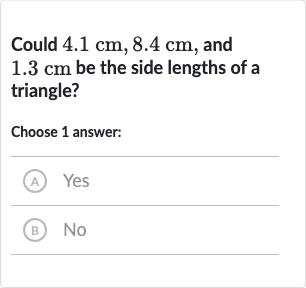Full solution
Q. Could , and be the side lengths of a triangle?Choose answer:(A) Yes(B) No
- Check Triangle Inequality Theorem: To determine if three lengths can form a triangle, we use the triangle inequality theorem, which states that the sum of the lengths of any two sides of a triangle must be greater than the length of the third side. We will check this for all three combinations of sides.
- Calculate First Combination: First, we check if 4.1\,\text{cm} + 1.3\,\text{cm} > 8.4\,\text{cm}. Performing the calculation, we get 5.4\,\text{cm} > 8.4\,\text{cm}.
- First Combination Result: The sum of and is not greater than , so the lengths , , and cannot form a triangle according to the triangle inequality theorem.
- Conclusion: Since one of the conditions of the triangle inequality theorem is not satisfied, we do not need to check the other conditions. We can conclude that these lengths cannot form a triangle.
More problems from Is (x, y) a solution to the system of equations?
QuestionGet tutor help

